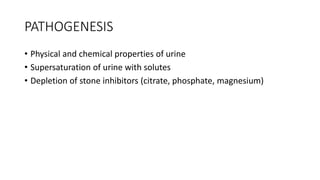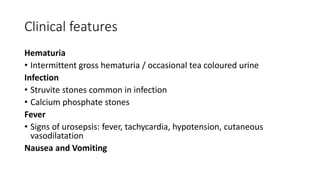This document discusses urolithiasis, or kidney stones. It begins by introducing kidney stones as the third most common pathology after UTIs and prostate issues. It then covers the pathogenesis, risk factors, classifications, varieties, clinical features, evaluations, and treatments of kidney stones. Key points include that calcium stones make up 70-80% of cases, struvite and cystine stones are also common, risk factors include diet, fluid intake, family history, and medical conditions. Evaluations involve urinalysis, imaging like ultrasound or CT, and stone analysis. Treatments depend on stone location and size, with drainage for infected or obstructed cases.




































































